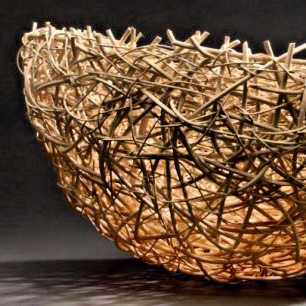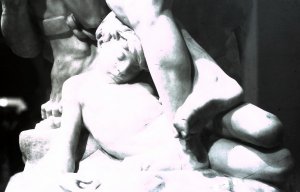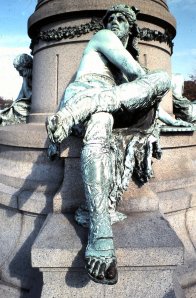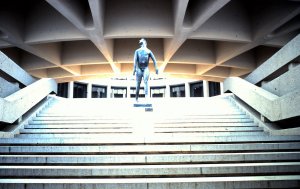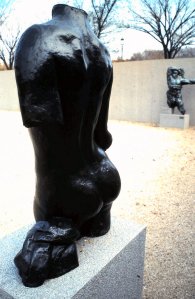After completing my masters degree in 1980 at Uof L through independent textile study with Alma Lesch, during her last year as adjunct professor of graduate school before retiring to studio work, I was allowed to observe the making of and, upon its completion, help deliver this site specific tapestry, commissioned for the ground floor lobby of Meidinger Tower, on the corner of Fourth opposite the Seelbach. Similar to any epiphany, and indeed near that singular Merton moment many years before at the same location, was how this tapestry, called Lay of the Land: Kentucky, in 1983, would spread before me for the first time, having not seen the whole composition flat as it would hang on the stone wall. I then realized that Alma Wallace Lesch (1917-1999) was seeing this also for the first time. I was fortunate to have been asked to help document the making of the piece in a studio that would not accomodate the full size of the finished piece. It was as if I were photographing an undulating landscape filled with valleys and hills sparkling under the light of the summer sun. Only when hung can the glint of the commonwealth’s shape be seen. If not the largest textile collage she had executed, Lay of the Land: Kentucky was an expansive view, nothing identical to the smaller ‘sketch’ called Kentucky Landscape, 1982 a square shape when compared to this newest textile panorama. Today, after sale of the building and eventual determination that the Owensboro Museum of Art would gain the tapestry, I trust the major fiber work is available for art viewers in Owensboro. Detail photos of the above photo collage @ http://almawallaceleschdatabase.blogspot.com/
The small rectangular fabric portrait seen in the above photo collage (a life size composition) shows details and photos of a commission in progress. Entitled “Sallie”, I purchased this signature portrait from the Kentucky Foundation of Art and Craft’s curated retrospective of the artist’s life work in 1997. Sallie, named in tribute to the matriarch of the Louisville Bingham family, “Sallie” graced the walls of the then called Kentucky Foundation of Art and Craft (now KMAC on West Main St.) in the 1997 Lesch exhibition (WHAS-11 TV archive/Bernson video). I view “Sallie” as the closest thing to knowing the artist herself, perhaps in the image of her mother, or in her own, mature, self-portrait in what would be our modern new Century, with it’s first Great War, early impressions buried in her childhood memory, or America’s post-Victorian lace days to come. Was clothing ever as disposable as now in our New Depression of this 21st Century?
Do we have the vision to see clothing as having a “life” as did Alma Lesch? She approached each idea for fabric portraits as if they contained the ‘essence’ of the clothed person. As that one instant she bought the denim off the back of a laborer who stood at her front door! Similar in scope to superstitious Picasso, who feared others possessing his thrown away clothing, Alma Lesch may have realized the power and scope when using clothing as a medium. Crediting Picasso with the innovation of today’s “art marketing” trend, Alma Lesch despised the idea of a value driven art market, posthumously. We had the most interesting conversation one night in the late ’90s while doing finishing work together late into the Saturday A.M. hours after mentioning Picasso and the millions attached to his work after his passing when she shared the plan for her bonfire. “I don’t want people getting rich off my work. Why shouldn’t I just control this problem? The minute you’re dead they can do anything with all that work. I’m just going to burn it in the yard.” Then she emitted her wonderful laugh, a single, strong one-note …HUH!
I’ve always admired direct conversation. Many of my best friends happen to be strong women. In fact, many of my most influential teachers, coincidentally, have been women. Just after Alma’s unexpected death a prominent fiber artist called for information about the disposal of Mrs. Lesch’s life work, stating: “After you are dead, you have no control over what you leave.” Then coldly stated, “When is the auction?” I had nightmares of cash registers larger, louder than the manual monstrous one than came out of (husband of Alma) Ted’s closed drugstore in Shepherdsville. Alma was right to see her ‘body of work’ (see University of Louisville archive) in that light when it came to ‘marketing’ or ‘profit’. To that fiber person on the phone I simply said, “What auction?”
There was a guilt collector, well known throughout the country, who would constantly approach Alma Lesch trying to gain access to her exquisite quilt collection, now dispersed. Alma Lesch thought this collector had misrepresented the poor people she would acquire good pieces from in order to feed her publishing and marketing agenda. That is the politics of art. Her own hand-made quilts, luckily, are in the archive at UofL thanks to Millard Lesch. A sizable collection of acquired works from auctions and friends has remained in one private collection. This collection should see exhibition some day.
The green, warm May of 1999 confirmed for me what conceptual artist Yoko Ono once said: “Each time we don’t say what we want to say, we’re dieing.” Thinking back two years, when my silence, and instant muted disbelief and sadness about NOT having the opportunity of seeing all these wonderful Alma Lesch textile collages (protected in an archived collection) and telling her to think about another plan (setting up a trust) may have aborted this idea: there was no bonfire of the Vanities after all. I do remember saying to her when she spoke of destroying all her unsold work (…but only after giving friends preselected pieces) that she got the idea from Picasso, who invented this concept of art promotion in modern times. I said, “Picasso treated women like crap. After profiting from their psychological torment by painting them, why does the art world admire such a “devil” except for the money he generates from media driven demand. He made the art market itself become a household word back when you both were in LIFE magazine in the 60s…that’s always the thing in the public mind.” Consider Van Gogh’s “Irises” now in a Japanese vault, maybe keeping a corporation from financial collapse? Art as currency, how creative an idea, especially now in this economic downturn post-Bush.
Coming of age living on a family farm in western Kentucky during The Great Depression may have honed Alma Lesch’s appreciation for clothing as being as valuable as gold. One of the first fiber artists to collect and , what we now call, up cycle the worn garments of ‘real people’; perhaps she was aware that she was creating portraits of her community, city and “everyman” beyond our commonwealth. To imagine the conversation that occurred when she bought the bib-overalls off the back of a man who appeared at her front door as hired help, one can only suggest the spirit of that ‘everyman’ in the composition inspiring another portrait, the moment Alma Lesch saw that fabric.
The body of work Lesch leaves behind, although a missing green Victorian satin portrait of a young boy remains unaccounted for, will offer future opportunities for exhibition and study through the University of Louisville.
